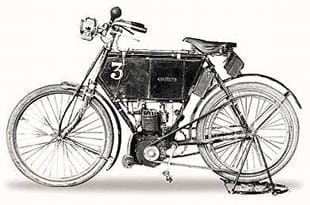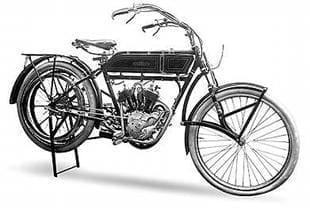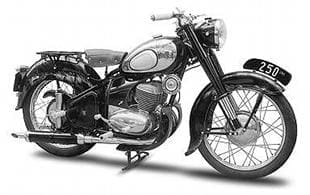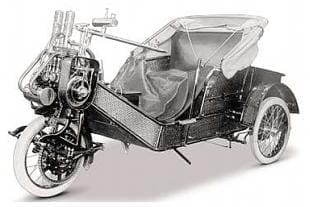
Peugeot 1899-Present France
Today a renowned car and commercial vehicle maker, and also leaders in the twist and go scooter/moped marketplace. Considering their world standing, it seems impossible to believe the founder Jean-Frederic Peugeot opened his tiny business in 1811 at d’Herimoncourt making stays for ladies’ corsets.
Much later, due to the demand of top quality spring steel, the founder’s sons Emile and Jules moved the factory to a former mill in Beaulieu. And it was here the first Peugeot vehicle was built in 1882, an ordinary cycle (penny farthing) named the Grand Bi. As the 19th century drew to a close a third generation of Peugeots were in control, Ammand and Eugene, grandsons of the founder and the business which had enjoyed a number of titles over time including Peugeot Bros had become Les File De Peugeot Frere – The Sons of the Peugeot Brothers.
As with any progressive company, Peugeot were eager to look at new up-and-coming markets and by 1899 had begun fitting proprietary clip-on engines to cycles, tricycles and quadracycles. They also started engine development work. In 1902 Peugeot took a leap forward by adopting the so-called Werner engine position in their motorcycles, with the unit mounted within the main frame. Patent infringements were avoided by splitting the bottom bracket of a purpose-built heavyweight cycle-type frame to site the engine and brazing a bracket between the front stanchion and saddle tube.
 In 1904, Peugeot adopted Truffault suspension for selected models. Peugeot also took an active interest in motorcycle sport from the outset to publicise their wares and by 1905 had become renowned record breakers and successfully entered teams in events such as the Circuit des Ardennes. Not only were they fitting their own up to 7hp automatic inlet valve V-twin engines in their roadsters, they were also supplying them to rival factories as proprietary units. And superb they were too, with a 5hp version powering Rem Fowler’s Norton to a multi-cylinder class at the 1907 IoM TT win chased in by Billy Wells on a Vindec, another company who used Peugeot power.
In 1904, Peugeot adopted Truffault suspension for selected models. Peugeot also took an active interest in motorcycle sport from the outset to publicise their wares and by 1905 had become renowned record breakers and successfully entered teams in events such as the Circuit des Ardennes. Not only were they fitting their own up to 7hp automatic inlet valve V-twin engines in their roadsters, they were also supplying them to rival factories as proprietary units. And superb they were too, with a 5hp version powering Rem Fowler’s Norton to a multi-cylinder class at the 1907 IoM TT win chased in by Billy Wells on a Vindec, another company who used Peugeot power.
Henri Cissac and J Giuppone continued in their record-breaking ways, often at cycle tracks, including Canning Town, London, where Cissac riding a 16hp model 50kg machine hit 87.32mph for the flying kilometre in 1905 and J Giuppone averaged 63.41mph for the hour at Parc des Princes near Paris. While all this high-speed fun was happening on dodgy cycle tracks, plans were afoot for the first purpose-built motor racing track, Brooklands. The Weybridge track’s first ever motorcycle challenge between two Oxford undergraduates involved Peugeot power in Oscar Bickford’s 670cc Vindec Special, who trailed homeW Gordon McMinnies’ 476cc Triumph on 25 February 1908.
Later, on Easter Monday 20 April, Peugeot power triumphed as Will Cook’s huge 984cc NLG-Peugeot led home Eddie Kirkham’s equally large 984cc Leader-Peugeot by over half a mile in the first official motorcycle race at Brooklands. Fired by this and many more successes across Europe, the company enthusiastically continued to be an engine development world leader. Later Jean Antoinescu joined the team and by 1912/13 had come up with first a 500cc parallel twin race engine with gear driven dohc, then four valves per combustion chamber and later a bevel-gear-driven sohc design. True, these were race not production units, but for a time Peugeot like Indian led the way with innovative performance development.
 Alongside racing, Peugeot was also earning a fine reputation for their roadsters, predominately based on a V-twin programme and during WWI they supplied a neat single-speed 380cc ice V-twin to the French forces. The standard machine was adapted for military dispatch and liaison duties and given service livery. After the war, Peugeot’s motorcycle division continued with more of the same, a racing programme and worthy roadsters comprising 300 to 750cc V-twins. By 1921 a 270cc single cylinder two-stroke had joined the range – it was a sign of things to come.
Alongside racing, Peugeot was also earning a fine reputation for their roadsters, predominately based on a V-twin programme and during WWI they supplied a neat single-speed 380cc ice V-twin to the French forces. The standard machine was adapted for military dispatch and liaison duties and given service livery. After the war, Peugeot’s motorcycle division continued with more of the same, a racing programme and worthy roadsters comprising 300 to 750cc V-twins. By 1921 a 270cc single cylinder two-stroke had joined the range – it was a sign of things to come.
By 1923 Antoinescu had developed their top works racing machine into a four-speed sohc 500 in uprated cycle parts. Ridden by Gillard, Pean and Richard they scored many wins and places, with a best year in 1923 winning major races at Lyons and Marseille as well as further international GPs in Italy, Switzerland and Spain. However, an all-out effort to win the 1924 Senior IoM TT ended in near failure with an 11th for Gillard, 14th for Pean and retirement for Richard. Although the works team survived for another couple of years, the two-stroke utility market was the way forward identified by the Peugeot management.
Regular updates saw Peugeot keep with and even ahead of rivals and by 1933 many models were of unit construction design. While sporting models were built, including the 515cc ohv twin-port single, much income was made from under 100cc Velomoteurs. Mostly they were pedal start single speeders which an enlightened French government allowed anyone old enough to ride, with licence and road tax unnecessary. During the early Thirties the Peugeot management had split the cycle and motorcycle division from the automotive side of the company to form Cycles Peugeot.
 Although continuing range development, including 350/500cc sports and touring models into the early days of WWll, Peugeot was badly hit by the war. Motorcycle production halted in 1940 as the Germans occupied France and later the retreating invading forces plundered and damaged Peugeot factories. Resumption of motorcycle production was slow, first the Beaulieu premises was to be rebuilt, then the management decided it too small for the planned level of manufacture. The acquisition of the SMHR works in Dannemarie, which was run alongside the Saint-Louis Peugeot factory, saw Peugeot introduce a new range of 50-250cc two-stroke machines, though there was no re-introduction of four-stroke models. Despite adding a 350cc twin to the range, motorcycle sales slipped until by the late 1950s they dropped motorcycle manufacture.
Although continuing range development, including 350/500cc sports and touring models into the early days of WWll, Peugeot was badly hit by the war. Motorcycle production halted in 1940 as the Germans occupied France and later the retreating invading forces plundered and damaged Peugeot factories. Resumption of motorcycle production was slow, first the Beaulieu premises was to be rebuilt, then the management decided it too small for the planned level of manufacture. The acquisition of the SMHR works in Dannemarie, which was run alongside the Saint-Louis Peugeot factory, saw Peugeot introduce a new range of 50-250cc two-stroke machines, though there was no re-introduction of four-stroke models. Despite adding a 350cc twin to the range, motorcycle sales slipped until by the late 1950s they dropped motorcycle manufacture.
However, cycles, mopeds and for a time the Bima mini-scooter did well. A range of well styled scooters were tried in the mid-Fifties – unfortunately the name labels S55, S57, S57C etc were less imaginative.
For survival, Peugeot had again made the right decision. The demand in France for mopeds grew year on year leading the factories at Beaulieu and Mandeure to continually step up production, the SMHR works was also enlarged and a development unit was set up a Dijon. By the mid-Seventies the Peugeot range comprised over 40 models, from ultra cheap basic 50cc single speed mopeds to 80cc sports lightweights. Cleverly, many of the moped models on identical 49cc two-stroke unit.
Sales again declined as the Seventies rolled by and after a brief business flirtation with Gilera, by then owned by Piaggio, and the use of a Honda engine in a scooter, Peugeot slimmed their range and began to regroup once more.
Mopeds continued but were progressively joined by scooters. Not just any old scooters, but sexy modern twist and go machines with attractive names, style, colours and graphics. These scooters took Europe by storm and remain market leaders today, with even a compressor (supercharged) 125 in the range and possibly more bigger scooters planned.
Phanomen 1903-40 Germany
Originally a leading German pioneer maker of large V-twin and single cylinder motorcycles. These were later all but phased out enabling the works to concentrate on the Phanomobil three-wheeler range, one with an 888cc (82 x 88mm bore and stroke) side-valve V-twin motorcycle engine mounted on the spring front fork.
Imported into the UK by The New Era Motor Co, 8 Lonsdale Road, West Kilburn, London, the three-wheeler had tiller steering and Nala two-speed hub gear. Later, up to 3.2 litre four-cylinder cars were built at the Zittau Phanomen works including an ohc model.
Motorcycle manufacture resumed in quantity in 1930 with a Sachs two-stroke engined motorised cycle. Later, Rudi Albert designed 98 and 123cc Sachs two-stroke engined lightweights which were added to the range. In 1935, the factory was nationalised and turned over to the manufacture of Robur trucks. A few Phanomobil three-wheelers survive, including one or two in the UK.
Phanomen 1949-c1956 Germany
Another brand name for mopeds and up to 197cc two-stroke motorcycles, built by renowned cycle makers Meister Fahradwerke.
Cycle maker Meister Fahdradwerke began motorcycle production in 1949 using Sachs and Ilo two-stroke engines, many with neat telescopic front forks and plunger style rear suspension. Later, a Zundapp-engined moped joined the range. The 98-197cc motorcycle range, designed by Alfred Osterag, was also marketed as the Mammut. Good spares availability in Germany for many proprietary parts.
Phillips 1954-64 UK
Began by offering Rex cyclemotor attachments fitted to their cycles, then progressed to building mopeds with the launch of the Gadabout moped in 1956. Production was based at Phillips Cycle Ltd, Credenda Works, Smethwick, Staffs. A couple of years later the Panda moped joined the range. This was later updated giving MkII and MkIII versions.
Phoenix 1900-08 UK
Factory founded by well-known racing cyclist and leading cycle track racing motorcyclist J Van Hooydonk. Manufacture began with 211cc automatic inlet valve Minerva kits fitted to sturdy cycles then moved on to installing a range of up to 433cc single cylinder Minerva engines with Longuemare carburettors to their own motorcycle frames.
As well as standard framed models, the factory introduced a small range of 269/345cc dropped frame motorcycles called the Phoenix Cob. By 1908, just the 402cc Fafnir engined Phoenix Cob was in production.
Competing against the likes of Tessier, the Collier brothers, Harry Martin and Barnes as well as the French stars headed by Cissac and Fournier, Van Hooydonk raced his Pheonix motorcycles at many leading UK venues including Canning Town and Crystal Palace cycle tracks. A moderate number of Minerva-engined models survive.
Phoenix 1956(1953)-64 UK
Ernie (Eric in some publications) Barrett first hit the headlines in 1948 with a second place in the lightweight MGP. Moving onto the IoM TT in 1950, he never enjoyed the same success recording an 11th in the 1952 Lightweight just over 14 minutes adrift of Fergus Anderson’s winning works Moto-Guzzi as a best finish. But in 1953 he joined an elite group of TT riders who ‘raced wot they built’, posting 12th in the lightweight astride his 250cc Phoenix-JAP, though he retired larger versions in the Junior and Senior races.
With Ernie Barrett’s guidance, HB Engineering of Tottenham, London unveiled their first scooter, the 147cc Villiers engined ‘Pheonix 150’, at the 1956 London Show. Rapidly, the range grew to include Standard and De-Luxe Versions and, later, 175 and 200cc Villiers engines were also employed. Electric start became an option as did 250 power, using the Villiers 2T twin. By 1959, the models were coded S for single cylinder models and T for twins and a 325cc model was launched with Villiers 3T power.
As Villiers updated their engine range, Phoenix dropped old favourites such as the 30C in favour of 31C power. Although behind Vespa and Lambretta in the style stakes, Phoenix scooters make worthwhile alternatives for the collector and there’s nothing wrong with Villiers power – for which spares for post WWII units are in good supply.



